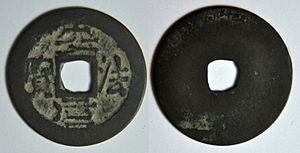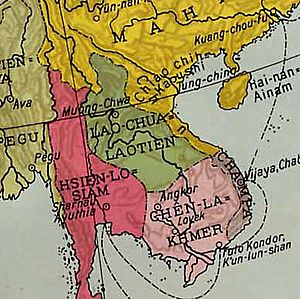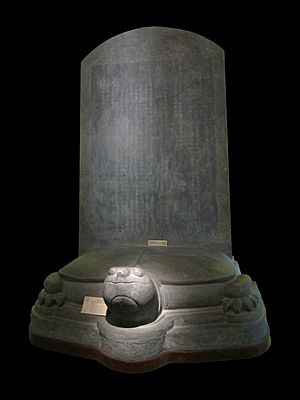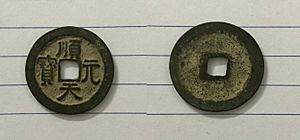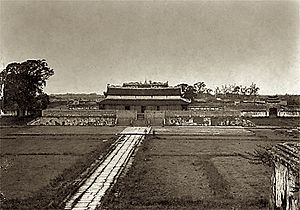Lê Lợi facts for kids
Quick facts for kids Lê Thái Tổ黎太祖 |
|||||||||||||||||
|---|---|---|---|---|---|---|---|---|---|---|---|---|---|---|---|---|---|
| Great Emperor of Đại Việt | |||||||||||||||||

Lê Lợi statue in front of the Municipal Hall of Thanh Hóa Province, the place of his birth
|
|||||||||||||||||
| Emperor of Lê dynasty Grand Prince of Đại Việt |
|||||||||||||||||
| Reign | 29 April 1428 – 5 October 1433 (5 years, 159 days) | ||||||||||||||||
| Predecessor | None | ||||||||||||||||
| Successor | Lê Thái Tông | ||||||||||||||||
| Born | 10 September 1384/1385 Lam Sơn , Thanh Hóa province |
||||||||||||||||
| Died | 5 September 1433 (aged 48) Đông Kinh, Đại Việt |
||||||||||||||||
| Burial | Vĩnh Tomb, Lam Sơn | ||||||||||||||||
| Spouse | Trịnh Thị Ngọc Lữ Phạm Thị Ngọc Trần |
||||||||||||||||
| Issue | Lê Tư Tề Lê Thái Tông |
||||||||||||||||
|
|||||||||||||||||
| Dynasty | Lê dynasty | ||||||||||||||||
| Father | Lê Khoáng | ||||||||||||||||
| Mother | Trịnh Thị Ngọc Thương | ||||||||||||||||
Lê Lợi (Vietnamese: [le lə̂ːjˀ], chữ Hán: 黎利; c. 10 September 1384/1385 – 5 October 1433), also known as Lê Thái Tổ, was a brave Vietnamese leader. He started the Later Lê dynasty and became the first emperor of the country of Đại Việt. This happened after Đại Việt was taken over by the Ming dynasty from China.
In 1418, Lê Lợi and his friends began a fight against the Chinese Ming rulers. This fight was called the Lam Sơn Uprising. He was famous for using clever guerrilla tactics. This meant his small groups would ambush the larger Ming armies. After nine years, his resistance movement successfully pushed the Ming armies out of Vietnam. Lê Lợi is one of the most famous and greatest heroes in Vietnamese history.
Contents
Why Did the Ming Invade Đại Việt?
In the mid-1300s, Đại Việt faced many problems. The ruling Trần dynasty became weak. The capital city, Thăng Long, even had a short civil war. From the south, the Chams, led by Chế Bồng Nga, attacked Đại Việt many times. They even sacked Thăng Long several times.
A reformer named Hồ Quý Ly took over the Trần royal family in 1399. This made the Chinese Ming dynasty angry. In 1406, 215,000 Ming soldiers invaded Đại Việt. They quickly defeated Hồ Quý Ly's army. They took over the country and renamed it Jiaozhi.
The Ming Chinese then tried to make Vietnam more like China. They wanted Vietnamese people to wear Chinese clothes and adopt Chinese culture. Some Vietnamese people in the capital supported the Ming. However, many people in the countryside resisted. Between 1415 and 1424, there were 31 uprisings against the Ming.
Lê Lợi's Early Life
Lê Lợi was born on August 6, 1385. He came from a noble family in Lam Sơn, Thanh Hóa province. His father, Lê Khoáng, was a rich landowner. The Lê clan was powerful in Lam Sơn for hundreds of years. This area had different ethnic groups, like Vietnamese and Muong people.
When Lê Lợi was a young man, the Ming Chinese invaded. He joined a revolt by two Trần princes against the Chinese. He was arrested and put in prison by the Chinese from 1413 to 1415. After he was released, he worked as a tutor and translator for the Ming.
Later, he had a problem with a neighbor who told the Ming he was a rebel. The Ming chased him back to his village. It was said that a Chinese official took Lê Lợi's nine-year-old daughter to China. This made Lê Lợi even more determined to fight. In early 1418, Lê Lợi started his resistance movement in Lam Sơn. He called himself Bình Định vương, which means "Prince of Pacification."
Fighting Against Ming Rule
The Lam Sơn Revolt (1418–1423)
| Lê Lợi | |
|---|---|
| Vietnamese name | |
| Vietnamese | Lê Lợi |
| Hán-Nôm | 黎利 |
Lê Lợi began his revolt against the Ming Chinese in February 1418. He had support from powerful families in his home province of Thanh Hóa. These included the famous Trịnh and Nguyễn families.
At first, Lê Lợi said he wanted to bring back the Trần family to power. A relative of the Trần king was chosen as a figurehead. But after a few years, Lê Lợi became the clear leader of the revolt.
| Temple name | |
| Vietnamese alphabet | Lê Thái Tổ |
|---|---|
| Hán-Nôm | 黎太祖 |
The Ming tried to stop the Vietnamese from getting new weapons. However, Lê Lợi's rebels made their own firearms. They copied weapons the Ming had used earlier.
In early 1418, Lê Lợi's men ambushed a Ming patrol. But a traitor showed the Ming how to attack Lê Lợi from behind. His group scattered, and he had to hide. Later, he gathered strength and ambushed the Ming again. In 1419, Lê Lợi attacked a Ming outpost and killed 300 enemies. He spent the next year recruiting more men. By late 1420, his forces controlled the Quan Hoa district.
In late 1421, a large Ming army attacked Lê Lợi. A Laotian army also joined the Ming. Lê Lợi thought the Laotians were his allies, but they sided with the Ming. By the end of 1422, Lê Lợi was defeated. He asked for peace and returned to Lam Son. The Ming offered a peace treaty, but they arrested Lê Lợi's messenger. Lê Lợi became suspicious and canceled the peace deal.
Taking Control of Nghệ An
In 1424, news reached Lê Lợi about changes in Ming policy. The new Ming emperor, Zhu Gaozhi, wanted to end costly adventures. He lowered the importance of holding Vietnam. This made Lê Lợi decide to restart his resistance.
Lê Lợi rebuilt his army. He marched south into Nghệ An. His forces ambushed a Ming group and advanced further. By the end of 1424, Lê Lợi's rebels had pushed the Ming army into Vinh, the capital of Nghệ An. Lê Lợi recruited thousands of soldiers from ethnic groups in the highlands. His forces then defeated an army of ethnic minority troops who had joined the Ming.
In 1425, Lê Lợi led armies both south and north. In the south, his soldiers defeated a Ming army in modern Quảng Bình. They gained control of the southern lands. In the north, Lê Lợi's men captured a Ming supply fleet. They then besieged the Ming forces at Tây Đô. Nguyễn Trãi, a smart scholar, helped Lê Lợi plan his army's strategy.
By the end of 1425, Lê Lợi's Vietnamese rebels had freed all the land from Thanh Hoa to the south. They had surrounded all the Ming forces in that area.
Pushing Northward
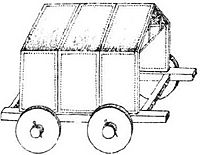
In 1426, Lê Lợi sent his armies north. His generals led troops through the mountains. They appeared at the Red River plain, threatening Dongguan. As Ming soldiers moved north, Lê Lợi followed, gathering thousands of men. He entered the Red River Delta and announced a Trần prince as king. Many people joined his army.
The Chinese general, Wang Tong, was ready to give up. But local people loyal to the Ming convinced him to fight. However, civilians in the Red River Delta welcomed Lê Lợi's army.
In December 1426, Lê Lợi's rebels won a surprise victory. They defeated a Ming army of about 30,000 soldiers in Tốt Động. Thousands of Chinese soldiers were killed or captured. The Vietnamese also took many horses, supplies, and weapons.
By 1427, the Vietnamese had learned new siege techniques. They used primitive tanks and powerful artillery. Five major Ming strongholds were under siege. Lê Lợi set up his main base across the Red River from Dongguan.
Final Victories
In March 1427, about 120,000 Chinese reinforcements arrived. They came from Yunnan and Guangxi. Lê Lợi knew how to deal with them. He sent his generals to wait at Chi Lang. He also had other forces ready to support them.
In September, Liu Sheng's 90,000-strong army was defeated in Chi Lang. Liu Sheng himself was killed. Another Ming general, Mu Sheng, heard this and ran away. Lê Lợi's forces chased him, killing 10,000 soldiers.
Lê Lợi knew that the Ming's control over Vietnam was ending. The Ming were not likely to try hard to take back control. By making Trần Cảo king, Lê Lợi fulfilled the goal of restoring the Trần dynasty. This had been the reason for the Ming's first invasion.
After a six-month siege, the Ming-held citadel of Xương Giang fell to Lê Lợi in October 1427. This ended the war. The Xuande Emperor of the Ming dynasty decided to pull his army out of Northern Vietnam. After this victory, the Vietnamese sent 86,640 Ming prisoners back to China. They also took all their weapons. This defeat was a huge disaster for the early Ming empire. China would not invade Vietnam again for 360 years.
Restoring Đại Việt
In 1427, after 10 years of war, Đại Việt became independent again. The Ming Empire officially recognized Đại Việt as a free state. On April 15, 1428, Lê Lợi became king of the restored Đại Việt kingdom. He chose his reign name Thuận-Thiên, which means "To obey Heaven."
Lê Lợi's Reign as Emperor
Lê Lợi officially re-established Đại Việt. The Ming Emperor recognized him as king in 1431. In return, Lê Lợi sent messages to the Ming court. He promised loyalty as a friendly state and paid gold. The Ming court accepted this. Lê Lợi also had good relations with the king of Champa.
Lê Lợi renamed the capital, Thăng Long, to Đông Kinh. This city is now known as Hanoi. He greatly reorganized the Vietnamese government. He gave high positions to his trusted friends and generals.
The new government rebuilt Vietnam's roads, bridges, and canals. Soldiers who fought in the war received land. Lê Lợi brought back the classical examinations for government jobs. He also created good administrative laws. With peace, soldiers were encouraged to settle in less crowded areas. This helped increase rice production and the population grew.
From 1430 to 1432, Lê Lợi and his army fought campaigns in the western hills. In 1433, he became sick. Before he died, he named his son, Lê Thái Tông, as his successor. He also appointed his prince Lê Sát as regent. Lê Lợi was given the posthumous name Thái Tổ.
Sadly, many of Lê Lợi's trusted advisors faced problems after his death. Some were executed or died under suspicious circumstances. Only Trịnh Khả lived to an old age, but he was also executed later.
Myths and Legends About Lê Lợi
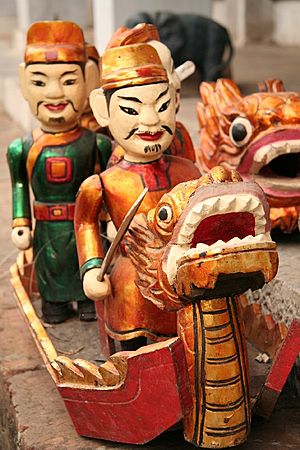
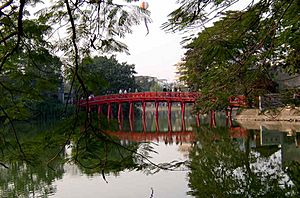
Many amazing stories are told about Lê Lợi. One story tells how a fox helped him escape death. When Ming soldiers were close, Lê Lợi hid in bushes. The soldiers sent dogs to find him. But the dogs found a fox with a human face instead. The fox ran away, and the dogs followed. The soldiers then killed the dogs for not doing their job. Lê Lợi escaped capture. After he became emperor, he built a shrine in that area. The fox spirit became a local god.
The most famous story is about his magical sword. Like King Arthur and his sword Excalibur, Lê Lợi was said to have a sword with wondrous power. The story says he got the sword, called 'The Will of Heaven' (Thuận Thiên), from the Dragon King. The Dragon King was a demi-god who decided to lend his sword to Lê Lợi.
The sword came in two parts: a blade and a hilt. First, a fisherman named Lê Thận found the blade. His fishing net kept catching a heavy metal piece. He threw it back three times, but it always came back. He then realized it was a sword blade. He took it home and put it in a corner.
Years later, Lê Thận joined Lê Lợi's army. One night, Lê Lợi visited Lê Thận's dark house. Suddenly, the blade in the corner glowed brightly. Lê Lợi picked it up and saw the words "Thuận Thiên" (Will of Heaven) appear. Lê Lợi took the blade with him.
One day, while running from the enemy, Lê Lợi saw a strange light from a banyan tree. He climbed up and found a sword hilt with precious gems. He put the blade into the hilt, and it fit perfectly. Lê Lợi believed Heaven had chosen him to free the land. He used the sword, and it brought him many victories. His men no longer had to hide. The sword helped them push back the enemy until Vietnam was free.
Lê Lợi became emperor in 1428. The stories say he grew very tall when he used the sword. It also gave him the strength of many men.
The stories mostly agree on what happened to the sword later. One day, after Vietnam was independent, Lê Lợi was on a boat in a lake in Hanoi. A golden turtle, Kim Quy, came towards his boat. With a human voice, it asked him to return the magic sword to its master, the Dragon King. Lê Lợi realized the sword was only lent to him for his mission. He drew the sword and threw it to the turtle. The turtle quickly caught the sword in its mouth and went back into the water. Lê Lợi then renamed the lake 'The Lake of the Returned Sword' (Hoan Kiem Lake).
Many poems and songs were written about Lê Lợi. He is seen as the perfect example of a fair, wise, and capable leader. Future Vietnamese kings were often compared to him.
Today, many major streets in Vietnam are named after Lê Lợi. In Hanoi, a street is named Lê Thái Tổ Street.
See also
 In Spanish: Lê Lợi para niños
In Spanish: Lê Lợi para niños
- List of Vietnamese dynasties


